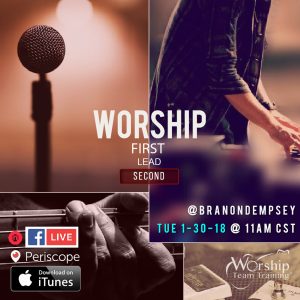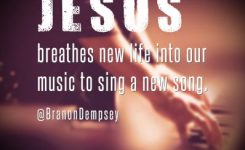Leaders, WTTU Special Public Post
Show #152 | “To Read or Not To Read” 1-30-18
Time: 30m video
Do You Read Music?
As a #WorshipLeader, do you struggle with band members who don’t read #music? Do you find it helpful if your team members read music?Does reading music limit your creativity, or allow you to have the tools needed to be even more #creative? Should you encourage your band and singers to learn how to #readmusic, and if so can you teach them?
Learn the value of reading music for members of a worship team and be able to understand if you should require your team to learn how to read music.
1-30-18 WATCH SHOW #152
Also Watch Live by: FacebookLive or Periscope
To Read or Not To Read
Should musicians in modern worship music read music or not? Is notated music a limiter or an inhibitor to creativity? Or, is it something that is genuinely helpful? In other words, is it worth the effort for the everyday church musician to learn how to read?We are in a rich season in modern worship music. In my memory, there has never been a time where more great congregational songs have been available. From a lyrical standpoint, writers are exploring more wonderful, poetic ways to express the same eternal truths we have been singing for centuries.
From a musical perspective, I would say it is an era of accessibility. Harmonically and rhythmically simple music is the norm in most evangelical circles. There are significant advantages to this as nearly anyone can successfully play the songs to facilitate a beautiful, meaningful corporate worship experience.
It doesn’t require a tremendous amount of skill or chordal knowledge. It can be played simply on the guitar or the piano, very often without the addition of any other instruments. In this way, these modern songs via digital distribution channels are sweeping the globe.
The Age of Accessibility
For the musician, one really can get by with just a lyric and chord chart. The music is straightforward enough and repetitive enough that musical notation isn’t always required. That isn’t to say that there isn’t musical sophistication in the way the songs are played. Musicians are applying themselves to the layering of parts and arrangements that are dynamic and powerful. Simple doesn’t necessarily mean simplistic.Take a listen to a simple four chord song like “With or Without You” by U2 and see how, though harmonically repetitive, the musicality and dynamic of the arrangement make the song far from boring. It is compelling and engaging in its simplicity due to the musicianship of the band.
Right now in the modern church, the listener’s ear is acclimated to this more stripped down approach to music. It is a response to a lot of things that came before it, and in some ways, it is a deconstruction of the previous generations music. Every generation needs to own their worship to renew and realign it for themselves.
This happens naturally for us all. We all, in some way, are responding to what has come before us. Every generation loads down the gospel with its baggage. And it is the next generation’s job to shed that baggage for themselves. They will get the opportunity to create all NEW baggage for those who come after them. This is how it has worked for 2000 years, and it is a good thing!
What we need to understand is we are indeed dealing with trends. Right now, the Churches’ ear is acclimated to more simple forms of music. But, all trends have a lifespan. There will come a time when the listener’s ear will want to hear something else. Perhaps it will be music that is more harmonically sophisticated, perhaps not. In my lifetime I’ve seen this ebb and flow a couple of times. The needle has bounced back-and-forth from more demanding to less demanding musical forms. The musician has a choice to adapt or do something else.
[ctt template=”6″ link=”7Pl1I” via=”no” ] “There has never been a time where more great congregational songs have been available.”[/ctt]
Lead Sheets or Chord Charts?
So back to our original question. Is it worth the effort for the everyday church musician to learn to read music? If we see the current musical simplicity as a trend, it might behoove us to look ahead. As a leader who was a music theory major in college I have played and lead groups in a dozen different styles of music. Though not impossible, it would be extremely cumbersome to try and do that without the ability to read music.
Music notation is a global language not unlike mathematics. You can go almost anywhere in the world, and though you don’t share the same spoken language, you can share the same musical language by just looking at the page. If the styles are going to change in the future, it seems we will be limiting ourselves unnecessarily if we can’t read musical notation. The forms and demands of future listeners will change.
As a musician, the more headroom I have in my ability, the more likely I will be able to adapt and serve the upcoming generation. There is no downside to having a larger musical vocabulary. It will creatively serve what I do now as well as what I can do in the future.
As a local church worship pastor, there has been some discussion that perhaps reading chord charts or lead sheets is a creative and collaborative limiter. I can understand how it can be seen that way by some. If you see the ink on the page as gospel and not a guideline, it can indeed be an unnecessary restraint to musical collaboration. In that case, the lyrics and chord chart leaves a certain sense of openness that is appealing.
In my experience, however, the notation can be seen as a guideline and a launching pad for further creativity and collaboration. With a well-written chart, rehearsals are more efficient and effective. The chart gives a shorthand and a starting point where skilled musicians can creatively explore. I will regularly depart from the chart in rehearsal or even in a worship service as either we follow our instincts or the Holy Spirit leading.
The notation need not be an obstacle. And as we grow, learn and adapt to future styles of music for the church, we will have a universally accepted foundation to serve us. It is very difficult to be too skilled at your craft as it is lead and mediated by the Spirit of God for the church that He is building.
[ctt template=”6″ link=”7Pl1I” via=”no” ] “Notation can be seen as a guideline and a launching pad for further creativity and collaboration.”[/ctt]
Reading the Language of Music
So, do you have to learn to read music? No. You don’t have to read music. But it certainly isn’t going to hurt you. And it may even help you facilitate worship for future generations who’s cultural and musical language is different from what you and I experience today.@BranonDempsey @worshiptt @WorshipTTU
 Troy Kennedy is the worship arts pastor for Westside Family Church leading worship at the Lenexa campus in Lenexa, KS, as well as participating on the teaching team. Having been a worship pastor for over 20 years, Troy’s experience has been broad, leading in a variety of environments including Saddleback Church in Southern California, pastored by Rick Warren.
Troy Kennedy is the worship arts pastor for Westside Family Church leading worship at the Lenexa campus in Lenexa, KS, as well as participating on the teaching team. Having been a worship pastor for over 20 years, Troy’s experience has been broad, leading in a variety of environments including Saddleback Church in Southern California, pastored by Rick Warren. Mentored early on by the likes of Tommy Walker and Rick Muchow he has been able to pass on his experience in conferences and workshops nationally. Troy has a degree in music theory from Azusa Pacific University with graduate work in theology from Golden Gate seminary.
He is also a prolific singer/songwriter for the church with a number of recordings to his credit. He is passionate to see the church engage powerfully in worship as people come to know Jesus intimately. God has blessed Troy with a beautiful wife Gwen, and two amazing boys, Grant and Trent. In his spare time he loves music, movies, playing with his kids, holding his wife’s hand and crossfit.
Want to watch MORE Worship Team Training Videos?
Not a WTTU Member, or Choose to Upgrade? Update Now
 Worship Team Training® Is your worship team stuck? Want worship leading to be better? Want to be free? We can take you there. Inspire, create and transform the leading of worship. Get a WeekendWorkshop
Worship Team Training® Is your worship team stuck? Want worship leading to be better? Want to be free? We can take you there. Inspire, create and transform the leading of worship. Get a WeekendWorkshopCopyright 2017 Worship Team Training®










